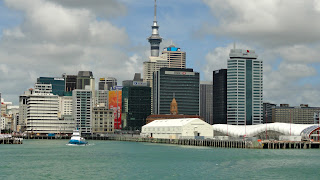 |
| Royal spoonbills nesting. |
Once man, especially Western man arrived with dogs, cats, stoats and other predators, that changed. Today many birds are extinct, including all of the Moas (you can see what Moas looked like at the excellent Otago Museum in Dunedin), and many more are in precarious numbers.
Naturally, those are the ones you want to see along with the albatross, gannets and penguins. I saw gannets on the North Island, the others on the South Island.
Frankly, your best bet is to visit a zoo for kiwi, the country's official bird, its colorful parrots and other non-flying birds. However, if you insist on seeing them in the wild, here are some tips.
 |
| Kiwi |
Kiwi
They are extremely shy and nocturnal. They frequent isolated beaches so Levelers, you'll have sand rather than steps to deal with. Midnight excursions aren't cheap and most New Zealanders have never seen one except in a zoo.
Stewart Island just off the South Island is where many birders go in search of this elusive and shy creature.
 |
| Penguin spotted during a Monarch Wildlife cruise. |
The tiny Blue penguin is extremely rare but I saw several during an overnight cruise in Doubtful Sound. You might also spot one or two in the water during a Monarch Wildlife Cruise outside of Dunedin.
 |
| Juvenile male yellow-eyed penguin, Penguin Place |
Tip: Levelers, binoculars and a very long lens for your camera will be necessary to see or capture images from easily accessed overlooks. Otherwise, expect hills, uneven ground and steps.
 |
| Female yellow-eyed penguin nesting, Penguin Place. |
Tip: Find out what season you're in to determine if it's worth the steps and climbs. Take the tour and you'll ride as close as possible in buses, but you will encounter uneven ground, changes in elevation and steps.
Albatross
 |
| Hold your hands out and compare it to this to see just how big an albatross can be. |
What you see depends on the season.
 |
| Viewing site |
 |
| Halfway there. |
 |
| Red-billed gulls nesting |
 |
| Red-billed gulls making chicks. |
From here you can see Pilots Beach, where a colony of blue penguins live, but the little buggers are so small you probably won't spot them.
 |
| White-capped albatross taking a break from fishing in waters between Stewart and Ulva Islands. |
I saw and photographed albatross close up on the Bluff ferry to and especially from Stewart Island.
 |
| Takahe at Te Anau Wildlife Centre. |
Saw all of these at the Te Anau Wildlife Centre, a free, self-guided conservation area on Lake Te Anau in the South Island's Fiordland. You may not see all of them; much depends on what the non-aviary birds are doing - or not doing.
 |
| World's largest accessible gannet colony at Cape Kidnappers. |
The world's largest accessible colony of gannets settles at Cape Kidnappers in the Hawkes Bay area of the North Island.
 |
| A big strand of seaweed is the way to a girl gannet's heart. |
All in all, even non birding enthusiasts will get a kick out of seeing these winged - or not - species, whether in a zoo or in the wild.
Personally, the more I travel the bigger my bucket needs to be to hold an ever-expanding list. How about you?
May we all have bigger buckets and more fulfilled wishes in 2012. Leia Mais…








































